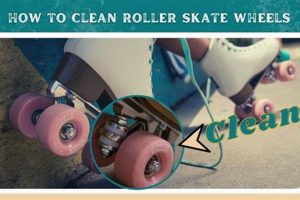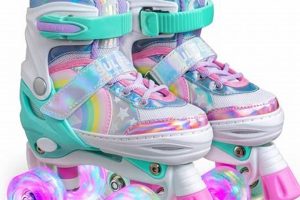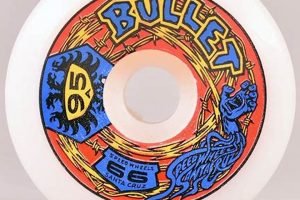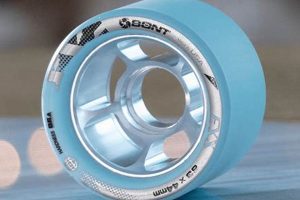Attaching larger, softer polyurethane rolling components, typically found on elongated skateboards designed for cruising, to a standard skateboard deck alters the riding experience. This modification often results in a smoother ride, improved grip, and the ability to traverse uneven surfaces with greater ease than with the smaller, harder wheels traditionally used on skateboards.
The adoption of these components on a standard skateboard configuration offers several advantages. It can provide increased stability and control, making it beneficial for beginner skateboarders or those seeking a more comfortable and less jarring ride. Historically, this practice has been employed by skateboarders looking to adapt their boards for transportation or for navigating rough terrain.
The following sections will delve deeper into the specific considerations for performing this type of modification, including wheel size and durometer selection, hardware requirements, potential limitations, and the impact on various skateboarding styles and maneuvers. These topics will provide a comprehensive understanding of the benefits and challenges associated with this specific setup.
Tips for Utilizing Oversized Polyurethane Rolling Components on Standard Skateboards
The following recommendations are designed to optimize performance and safety when adapting a standard skateboard with larger, softer wheels typically found on longboards.
Tip 1: Wheel Diameter Selection: Consider the wheel diameter carefully. A larger diameter (e.g., 70mm or larger) offers increased roll speed and the ability to overcome obstacles more effectively. However, excessive size may lead to wheel bite, where the wheel rubs against the deck during turns.
Tip 2: Durometer Considerations: Opt for a softer durometer (e.g., 78A-85A). Softer wheels provide enhanced grip and a smoother ride, particularly on rough surfaces. This is especially beneficial for cruising and transportation.
Tip 3: Riser Pad Installation: Riser pads are crucial. These elevate the deck, providing adequate clearance for the larger wheels and minimizing the risk of wheel bite. Experiment with different thicknesses to find the optimal balance between clearance and board feel.
Tip 4: Hardware Adjustments: Longer hardware is necessary to accommodate riser pads. Ensure the bolts are of sufficient length to securely fasten the trucks to the deck. Insufficient bolt length can compromise safety and stability.
Tip 5: Truck Adjustments: Loosen the trucks slightly to improve turning radius and compensate for the increased stability provided by the larger wheels. However, avoid excessive loosening, which can lead to instability at higher speeds.
Tip 6: Surface Evaluation: While large, soft wheels improve performance on rough surfaces, be mindful of debris. Larger wheels can pick up small rocks or other materials more readily, which can impact stability.
Tip 7: Riding Style Adaptation: Recognize that this configuration is better suited for cruising and transportation than for technical street skating. Ollies and other complex maneuvers may be more challenging due to the increased deck height and wheel size.
By carefully considering wheel diameter, durometer, riser pad installation, hardware, and truck adjustments, riders can effectively adapt a standard skateboard for a smoother, more versatile riding experience.
The following section will address potential issues and troubleshooting techniques associated with this setup.
1. Smoothness
The utilization of larger, softer polyurethane rolling components directly correlates with the resultant ride quality, specifically its smoothness. These wheels, owing to their increased diameter and reduced durometer, exhibit a greater capacity to absorb surface irregularities. This absorption mitigates the transmission of vibrations and impacts to the rider, thereby enhancing ride comfort and minimizing fatigue, especially on uneven terrain. For example, a skateboard equipped with standard, smaller wheels will transmit the impact of a small crack in the pavement far more directly to the rider than one fitted with larger, softer alternatives.
Smoothness contributes substantially to the practicality and versatility of skateboards. By reducing the jarring effect of rough surfaces, the rider can maintain control more easily and for longer durations. This becomes particularly relevant in urban environments where pristine pavement is not always available. Individuals using skateboards for commuting or transportation purposes benefit significantly from the increased smoothness. Furthermore, the enhanced comfort allows riders to focus on other aspects of skateboarding, such as maneuvering and navigating traffic, rather than constantly bracing for impacts.
In conclusion, the relationship between these larger, softer wheels and ride smoothness is one of direct cause and effect. The inherent properties of these wheels yield a demonstrably smoother ride, contributing to enhanced rider comfort, control, and overall practicality. Understanding this relationship is crucial for skateboarders seeking to adapt their boards for diverse riding conditions and purposes. Achieving smoothness will address terrain challenges while maintaining control.
2. Grip
The integration of larger, softer wheels on a standard skateboard significantly alters the available traction between the wheel and riding surface. This impacts control, safety, and the range of feasible maneuvers.
- Durometer and Contact Patch
Softer wheels (lower durometer rating) conform more readily to surface irregularities, increasing the contact patch. A larger contact patch translates to greater frictional force and enhanced grip. This allows for sharper turns and improved control, particularly on uneven surfaces. However, excessively soft wheels can deform significantly under load, potentially reducing responsiveness.
- Surface Conditions and Wheel Composition
Grip is directly affected by the interaction between the wheel’s polyurethane composition and the surface material. Certain polyurethane formulations exhibit superior grip on specific surfaces (e.g., polished concrete versus rough asphalt). Environmental factors such as moisture and temperature also influence grip. Wet surfaces inherently reduce friction, while extreme temperatures can alter the durometer of the wheel, affecting its grip characteristics.
- Impact on Maneuverability
Increased grip generally enhances stability and control but can also limit the ability to perform certain slides and drifts. Traditional skateboard wheels with higher durometer ratings are designed for controlled slides. The greater grip of larger, softer wheels necessitates a modified riding technique to initiate and maintain slides, requiring more force and a greater understanding of weight distribution.
- Speed and Rolling Resistance
The enhanced grip of larger, softer wheels comes at the cost of increased rolling resistance. While these wheels excel at maintaining traction during turns, they may exhibit slightly reduced top-end speed compared to harder, smaller wheels designed for minimal rolling resistance. This trade-off between grip and speed is a crucial consideration when selecting wheels for a particular riding style or application.
In summary, adapting a skateboard with larger, softer wheels offers a distinct advantage in terms of available grip. This enhanced traction facilitates improved control, stability, and maneuverability in varied surface conditions. However, riders must be aware of the trade-offs associated with increased rolling resistance and the potential impact on specific maneuvers such as sliding. The optimal wheel selection depends on the rider’s intended use and performance priorities, where these considerations must be carefully balanced against each other. The interplay of these factors is essential for the overall effectiveness of this adaptation.
3. Clearance
Adequate clearance is paramount when larger wheels, common on longboards, are integrated with standard skateboard decks. Insufficient distance between the wheels and the deck can result in “wheel bite,” a condition where the wheel contacts the deck during turning, abruptly halting the board and potentially causing a fall. Proper clearance ensures safe and effective operation.
- Riser Pads: Elevation for Function
Riser pads, typically constructed from plastic or rubber, are installed between the skateboard trucks and the deck to elevate the board. Increasing this vertical distance provides the necessary space for larger wheels to rotate freely without contacting the deck. For example, a skateboard using 70mm wheels might require 1/4-inch or thicker riser pads to prevent wheel bite. Riser pad selection depends directly on wheel diameter; larger wheels necessitate thicker risers.
- Deck Shape: Concavity and Cutouts
The concavity, or curvature, of the skateboard deck influences the severity of wheel bite. Decks with steeper concavity are more prone to wheel bite due to the closer proximity of the deck to the wheels during turns. Certain decks incorporate wheel well cutouts, which are sections of the deck removed above the wheels, providing additional clearance. Decks with cutouts allow for larger wheels with smaller or no riser pads.
- Truck Height: Influence on Ride Dynamics
Skateboard trucks are manufactured in various heights (low, mid, high). Higher trucks inherently provide more clearance between the deck and the wheels. Using higher trucks reduces the need for thick riser pads. However, truck height also affects the skateboard’s stability and turning characteristics; taller trucks generally offer greater turning leverage but can reduce stability at high speeds. Therefore, the selected truck height needs to achieve optimal balance and performance.
- Wheel Wells: Subtle Adaptation Strategy
Skateboard decks with wheel wells provide additional clearance for larger diameter wheels. These wells, pressed into the deck during manufacturing, create recessed areas that reduce the likelihood of wheel bite. Wheel wells can be combined with riser pads to maximize clearance, allowing for the use of even larger wheels or softer bushings. The inclusion of wheel wells facilitates performance enhancement or ride customization.
In summary, maintaining adequate clearance through the strategic selection of riser pads, deck shape, truck height, and wheel wells is a critical factor in successfully adapting a skateboard for use with larger wheels. Without sufficient clearance, safe operation is compromised. The optimal configuration balances rider preferences and performance needs while preventing wheel bite. Considering how these elements interact helps optimize rider performance.
4. Stability
The stability characteristics of a skateboard are significantly influenced by the size and durometer of the wheels employed. Substituting standard skateboard wheels with larger, softer alternatives, typical of longboards, fundamentally alters the board’s equilibrium and responsiveness.
- Wheel Diameter and Inertia
Larger diameter wheels possess a greater moment of inertia. This increased inertia makes the skateboard more resistant to changes in direction and speed, resulting in a more stable platform, particularly at higher velocities. This effect is analogous to a larger bicycle wheel offering greater stability compared to a smaller wheel at equivalent speeds. The trade-off is a reduction in maneuverability in tighter spaces.
- Wheel Durometer and Surface Contact
Softer wheels, indicated by a lower durometer rating, deform more readily upon contact with the riding surface. This increased deformation expands the contact patch between the wheel and the ground, enhancing grip. The expanded contact area contributes to a more secure and predictable ride, minimizing the likelihood of sudden slips or wobbles. However, excessively soft wheels can exhibit increased rolling resistance, potentially reducing speed and efficiency.
- Deck Height and Center of Gravity
Integrating larger wheels necessitates the use of riser pads to prevent wheel bite. These pads elevate the skateboard deck, raising the rider’s center of gravity. A higher center of gravity can decrease stability, particularly for inexperienced riders. Counteracting this effect requires adjustments to riding technique, such as maintaining a lower stance and distributing weight evenly. Proper adjustment of truck tightness may also be required.
- Truck Geometry and Turning Response
The geometry of the skateboard trucks, including the angle of the kingpin and the bushing durometer, interacts directly with the stability characteristics imparted by the wheels. Trucks designed for carving and cruising typically offer a more responsive turning radius, which can complement the increased stability of larger wheels. Conversely, stiff trucks can counteract the increased stability, resulting in a board that is less responsive to turning inputs. Careful truck selection and adjustment are essential to achieve the desired balance between stability and maneuverability.
In conclusion, adapting a skateboard with longboard wheels introduces multifaceted changes to the board’s stability profile. While larger wheels inherently enhance stability due to increased inertia and surface contact, the elevated deck height and truck geometry require careful consideration to maintain rider control. A balanced approach to wheel and component selection optimizes the benefits of this modification, offering a more stable and predictable riding experience, particularly for cruising and transportation purposes.
5. Speed
The attainment of increased velocity is a primary consideration when adapting a standard skateboard with larger wheels commonly found on longboards. This modification has a direct and quantifiable impact on the board’s potential for speed, influencing its suitability for various riding styles and applications.
- Wheel Diameter and Rotational Velocity
Larger wheel diameters inherently translate to greater linear distance covered per revolution. A wheel with a 70mm diameter will cover more ground with each rotation than a wheel with a 50mm diameter, assuming equivalent rotational speeds. This directly contributes to an increased top speed potential. However, this potential is also influenced by factors such as bearing efficiency and rider input.
- Wheel Durometer and Rolling Resistance
Softer wheels, characterized by lower durometer ratings, offer enhanced grip but also exhibit increased rolling resistance. The increased friction between the wheel and the riding surface can limit the board’s top speed potential, particularly on smooth surfaces. Conversely, harder wheels, while offering less grip, minimize rolling resistance and facilitate higher speeds on suitable surfaces. The selection of durometer is a trade-off between grip and speed.
- Bearing Quality and Frictional Losses
The quality and maintenance of the skateboard bearings play a crucial role in maximizing speed. Bearings with higher ABEC ratings and appropriate lubrication minimize frictional losses within the wheel assembly, allowing for smoother and faster rotation. Neglecting bearing maintenance can significantly impede the board’s ability to attain and maintain high speeds.
- Riding Surface and External Factors
The surface upon which the skateboard is ridden exerts a significant influence on speed. Smooth, paved surfaces allow for optimal speed potential, while rough or uneven surfaces introduce increased rolling resistance and limit speed. Additionally, external factors such as wind resistance and gradient (uphill or downhill) directly affect the board’s velocity. These factors are independent of the wheel size and durometer but must be considered.
In summary, the incorporation of larger wheels on a skateboard offers the potential for increased speed, contingent upon several interrelated factors. Wheel diameter, durometer, bearing quality, and riding surface all contribute to the board’s overall velocity profile. Riders must carefully consider these factors to optimize their setup for the desired balance between speed, grip, and control. The interaction of these elements creates the practical implications for reaching the desired speed.
6. Terrain
The suitability of employing larger, softer wheels, typical of longboards, on a standard skateboard is inextricably linked to the characteristics of the riding surface. These wheels, engineered to traverse varied and often less-than-ideal surfaces, present a distinct advantage over the smaller, harder wheels traditionally used on skateboards when navigating uneven or coarse terrain. The cause-and-effect relationship is straightforward: rougher terrain necessitates wheels that can absorb irregularities and maintain momentum. The importance of terrain as a component in this context lies in its power to either enable or severely limit the effectiveness of the skateboard. For example, consider the practical use of a skateboard for commuting across a city with inconsistent pavement quality; in this scenario, the capacity of the larger, softer wheels to roll smoothly over cracks, pebbles, and other surface imperfections directly translates to a more efficient and comfortable journey.
Further analysis reveals that the practical applications extend beyond mere commuting. Filming skateboarding in urban environments often requires traversing less-than-perfect surfaces to capture specific shots. Larger wheels provide the necessary stability and shock absorption to enable smooth camera operation and rider confidence. Similarly, skateboarders seeking to explore new and untraditional riding locations, such as gravel paths or cobblestone streets, find that the increased surface area and pliability of larger, softer wheels significantly enhance their ability to maintain control and momentum. This adaptation provides access to a wider range of environments, fostering creativity and exploration within the skateboarding community. For instance, using a standard skateboard on a rough asphalt path can lead to loss of control and momentum, but larger wheels enhance both.
In conclusion, the successful application of longboard wheels to a standard skateboard is largely determined by the intended terrain. These modifications facilitate smoother, more controlled rides on surfaces that would otherwise be challenging or impassable with traditional skateboard wheels. While challenges such as increased weight and potential limitations in performing certain technical tricks exist, the benefits related to terrain versatility and rider comfort are undeniable. This underscores the critical need to carefully consider the intended riding environment when selecting components and adapting skateboard setups, linking back to the central theme of optimizing performance based on specific conditions. Moreover, maintaining a higher speed on rougher terrain helps in the navigation process.
Frequently Asked Questions
The following addresses common inquiries and misconceptions surrounding the practice of equipping a standard skateboard with larger, softer wheels typically found on longboards. These questions and answers aim to provide clarity and informed decision-making.
Question 1: Does adapting a skateboard in this manner compromise its structural integrity?
The structural integrity of the skateboard is not inherently compromised, provided appropriate hardware and riser pads are utilized. Longer bolts are essential to accommodate the additional height provided by riser pads. Failure to use adequately sized hardware can result in insecure truck mounting and potential board failure.
Question 2: Will this modification hinder the execution of technical skateboarding maneuvers?
Yes, to a degree. The increased wheel size and deck height can make performing ollies and other technical street skating tricks more challenging. The added weight and altered center of gravity require adjustments to technique and may limit the execution of certain advanced maneuvers.
Question 3: Is this configuration suitable for beginner skateboarders?
It can be beneficial for beginners, offering increased stability and a smoother ride. The larger, softer wheels provide enhanced grip and the ability to navigate uneven surfaces more easily, which can foster confidence and accelerate the learning process. However, beginners should be aware of the altered handling characteristics and potential limitations.
Question 4: What is the optimal wheel durometer for this type of setup?
A durometer range of 78A to 85A is generally recommended. This range provides a balance between grip, smoothness, and rolling resistance. Softer wheels (lower durometer) offer greater grip and shock absorption, while harder wheels (higher durometer) roll faster on smooth surfaces. The optimal choice depends on the rider’s preferences and intended use.
Question 5: How does this modification affect the skateboard’s turning radius?
Larger wheels can initially increase the turning radius. However, this can be mitigated by loosening the trucks and selecting trucks with a geometry designed for carving. Experimentation with truck tightness and bushing durometer is often necessary to achieve the desired turning response.
Question 6: What are the primary benefits of using longboard wheels on a skateboard?
The primary benefits include a smoother ride, increased grip, the ability to traverse rough surfaces more easily, and enhanced stability. This configuration is particularly well-suited for cruising, transportation, and filming skateboarding in urban environments.
In summary, adapting a skateboard with these wheels offers a distinct set of advantages and disadvantages. Careful consideration of these factors allows for informed decision-making and optimal performance.
The following article section will provide guidance on component selection and setup recommendations.
Skate with Longboard Wheels
This exploration of skate with longboard wheels has illuminated the nuanced considerations inherent in modifying a standard skateboard with larger, softer rolling components. The analysis has encompassed the impact on ride smoothness, traction, clearance, overall stability, attainable speed, and terrain versatility. Implementing such a change necessitates a careful assessment of hardware requirements, potential limitations in technical maneuvers, and the intended riding environment. Successful adaptation hinges upon the judicious selection of components and meticulous setup adjustments.
The demonstrated potential for enhanced comfort and control across varied surfaces makes this modification a compelling option for those prioritizing cruising, transportation, or filming. The decision to skate with longboard wheels ultimately represents a conscious trade-off between traditional skateboarding performance and adaptable utility. As skateboarding continues to evolve, informed experimentation and a thorough understanding of component interactions will be critical in shaping future innovations and expanding the boundaries of the sport.







